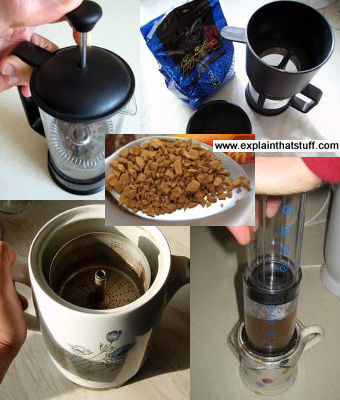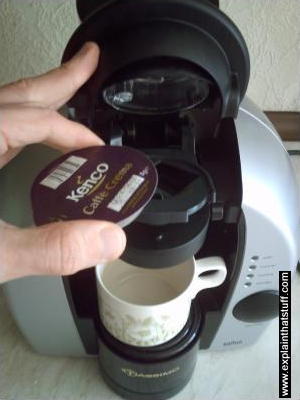
Single-serve "pod" coffee makers
by Chris Woodford. Last updated: December 26, 2021.
If you love a good cup of coffee but you can't be bothered with all the fuss of grinding beans, spooning out ground coffee, or boiling a kettle, a pod-coffee maker could be just the thing you're looking for. These truly idiot-proof machines pack all the mess and fuss into a simple, disposal plastic pod—as easy and convenient as a tea-bag—and they can deliver excellent quality coffee in a couple of minutes. Although they're quite expensive, they can quickly pay for themselves if you're in the habit of buying your drinks at the local coffee shop. Let's take a closer look at how they work!
Photo: The futuristic-looking Nescafé Dolce Gusto® Eclipse pod coffee maker. It looks great in my dentist's waiting room, but I wonder how many people use it? It's much less intuitive than any coffee machine I've ever seen: where do you put the water and the coffee? What do you press to start things off? Not a problem at home; more of an issue in an office or workplace. My dentist has had to write a long page of instructions...
Sponsored links
Contents
How to make a perfect cup of coffee
However you choose to make your coffee, you'll know there are two essential ingredients: water and the coffee itself. To make perfect coffee, the water must not be boiling hot: it needs to be slightly cooler, at a temperature of about 88–96°C (190–205°F); the exact temperature depends on the type of coffee you're using. As for the coffee, as most people surely know, coffee comes off the tree in the form of beans, which have to be processed in various ways, then roasted (cooked) and ground to a powder to release the flavor we all love.

Photo: Another popular pod coffee maker: the Braun Tassimo™ coffee pod machine. Rival machines are sold under Nespresso™ and Senseo™ brands. On this machine, the water tank is at the back, under the circular black lid. The pod fits into the silver compartment at the front, on top. Once you've load up the water and the pod, you press the large black button on the bottom right to deliver your coffee. That's all you have to do: fill up with water, insert your pod, and press the button. Nothing could be simpler!
To turn ground coffee into drinkable coffee, you put the water and the coffee together—but different coffee-making techniques do this in different ways:
- Cafetière (French press): You simply spoon ground coffee into the pot and pour hot water over it. The water slowly releases the flavor from the coffee grounds, as convection currents swirl them around. It takes about 5 minutes to make a decent pot.
- Filter coffee: You put the coffee inside filter paper and pour boiling water over it. A "pour-over" as this is sometimes known, can make excellent coffee, but it's also a bit of a fiddle and it can be messy.
- Percolator: Hot water is endlessly bubbled through a metal coffee container at the top of the machine to make very strong coffee. The trouble here is that you have to clean out the percolator and its mechanism when you're done.
- Instant coffee: The easiest coffee of all. You put a spoon of coffee powder (containing concentrated coffee essence) into the bottom of your cup and pour near-boiling water over to make it dissolve. There's nothing to clean beside your cup, but the coffee usually tastes diabolical.
- Coffee-shop machine: The espresso machines you see in coffee shops usually make the best coffee. They work by heating water quickly to the perfect temperature, before forcing it at high pressure through a metal vessel containing ground coffee. But professional machines are expensive and it takes great skill to use one properly. They're also a pain to clean.

Photo: Coffee-making methods. Clockwise from top left: French press, filter, Aeropress, percolator, instant (center photo).
So... lots of coffee-making methods but ultimately one simple choice: you can either have quick-and-easy, bad-tasting coffee or you can have decent coffee but suffer the time and trouble of making it. In the last few years, however, ingenious coffee companies have hit on a way to let us enjoy coffee-shop quality at instant-coffee speed: the coffee pod machine.
From K-Cup® and Tassimo™ to Nespresso™, Senseo™, and Dolce Gusto™, there are quite a lot of different pod machines available. Even so, the basic principle is pretty much the same in each case. You start off with a pod (ground coffee inside a plastic container lined with filter paper and sealed with foil) and place it inside your machine, which breaks through the foil automatically. The machine heats the water to almost boiling (probably about 90°C or 190°F or so), then forces it at high pressure through the coffee in the pod into your cup, in a similar way to a traditional espresso machine. Machines such as the Tassimo have separate coffee and milk pods (typically containing UHT milk), although you can always leave out the milk pod and add your own fresh milk (or frothed milk, if you're making a cappuccino) later.

Photo: Making coffee with the Braun Tassimo. You take a pod (t-disc) like this one, loaded up with ground coffee, and insert it into the machine. The machine reads the barcode on the top and figures out exactly what to do. Different coffee pods will make the machine behave in different ways, pausing longer before they start forcing the water through, using different amounts of water, or whatever. The point is that the machine does all that for you. All you have to do is press a single button to deliver a great cup of coffee in a minute or two.






